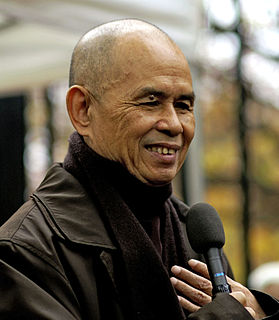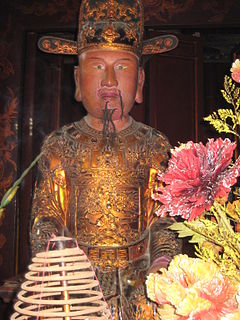
Vạn Hạnh Zen Temple is a Zen Buddhist temple in Ho Chi Minh City, the largest city in Vietnam. The temple is located at 716 Nguyễn Kiệm Street on the road between Go Vap and Phu Nhuan districts. It is the location of the main Buddhist training centre for sangha in Vietnam, and is also the office of the Vietnamese Buddhist Research Institute. [1]

Zen is a school of Mahayana Buddhism that originated in China during the Tang dynasty as the Chan school (Chánzong) of Chinese Buddhism and later developed into various schools. Chán Buddhism was also influenced by Taoist philosophy, especially Neo-Daoist thought. From China, Chán spread south to Vietnam and became Vietnamese Thiền, northeast to Korea to become Seon Buddhism, and east to Japan, becoming Japanese Zen.

Ho Chi Minh City, also known by its former name of Saigon, is the most populous city in Vietnam with a population of 8.4 million as of 2017. Located in southeast Vietnam, the metropolis surrounds the Saigon River and covers about 2,061 square kilometres.

Vietnam, officially the Socialist Republic of Vietnam, is the easternmost country on the Indochina Peninsula. With an estimated 94.6 million inhabitants as of 2016, it is the 15th most populous country in the world. Vietnam is bordered by China to the north, Laos and Cambodia to the west, part of Thailand to the southwest, and the Philippines, Malaysia, and Indonesia across the South China Sea to the east and southeast. Its capital city has been Hanoi since the reunification of North and South Vietnam in 1976, while its most populous city is Ho Chi Minh City.
Before the fall of Saigon in 1975, the site of the temple was the campus of the school of applied science of Vạn Hạnh Buddhist University, under the leadership of Thích Minh Châu. In 1976, with the reunification of Vietnam. It was converted into a Zen meditation temple and Buddhist research centre. [1]

The Fall of Saigon, or the Liberation of Saigon, was the capture of Saigon, the capital of South Vietnam, by the People's Army of Vietnam (PAVN) and the Viet Cong on 30 April 1975. The event marked the end of the Vietnam War and the start of a transition period to the formal reunification of Vietnam into the Socialist Republic of Vietnam.
The temple is located on a block of land of one hectare in size. It comprises a main ceremonial hall, a patriarch hall, living and dining quarters for the sangha and separate facilities for various educational institutions. These include the office of the Vietnamese Buddhist Research Institute, the office of the Society for the Translation of the Mahayana sutras and the main Buddhist training centre in Vietnam, which trains Buddhist sangha. [1]
The temple fate was built in 1990 along the architectural model of the Buddhist temples in the central city of Huế, under the administration of Thích Tâm Đoan and Thích Tịnh Quang. The main hall is two-storied. The ground storey is the main ceremonial hall, with a white statue of Gautama Buddha seated on a lotus in the centre of the hall. One either side of the main hall are reading rooms of the temple's library, which stocks a large range of religious documents. The upper storey contains the guest room and the office of the abbot. [1]

Huế (Vietnamese: [hwě] is a city in central Vietnam that was the capital of Đàng Trong Kingdom from 1738 to 1775 and of the Nguyễn Dynasty from 1802 to 1945. A major attraction is its vast, 19th-century citadel, surrounded by a moat and thick stone walls. It encompasses the Imperial City, with palaces and shrines; the Forbidden Purple City, once the emperor's home; and a replica of the Royal Theater. The city was also the battleground for the Battle of Huế, which was one of the longest and bloodiest battles of the Vietnam War.

Gautama Buddha, also known as Siddhārtha Gautama in Sanskrit or Siddhattha Gotama in Pali, ShakyamuniBuddha, or simply the Buddha, after the title of Buddha, was a monk (śramaṇa), mendicant, sage, philosopher, teacher and religious leader on whose teachings Buddhism was founded. He is believed to have lived and taught mostly in the northeastern part of ancient India sometime between the 6th and 4th centuries BCE.
The patriarch hall of the temple is also two-storied. The upper storey is for paying homage to the Buddha and to the patriarchs. On the altar of the patriarch altar is Thích Tịnh Khiết, the first head of the United Buddhist Congregation of Vietnam. The ground floor serves as the dharma hall, where dharma talks are held. [1]

Dharma is a key concept with multiple meanings in Indian religions like Hinduism, Buddhism, Jainism, Sikhism and others. There is no single-word translation for dharma in Western languages.
Vạn Hạnh Zen Temple is the working office of the Buddhist Research Institute of Vietnam, where a team of Buddhist scholars works under Thích Minh Châu, who holds a doctorate in Buddhism and psychology. The institute is divided into departments, one for Vietnamese Buddhism, world Buddhism and one for printing and distribution. Another team is devoted towards translating Mahayana scriptures from Chinese into Vietnamese, in addition to the translation of the Pali Canon. [1]

Mahāyāna is one of two main existing branches of Buddhism and a term for classification of Buddhist philosophies and practice. This movement added a further set of discourses, and although it was initially small in India, it had long-term historical significance. The Buddhist tradition of Vajrayana is sometimes classified as a part of Mahāyāna Buddhism, but some scholars consider it to be a different branch altogether.

Chinese is a group of related, but in many cases not mutually intelligible, language varieties, forming the Sinitic branch of the Sino-Tibetan language family. Chinese is spoken by the ethnic Chinese majority and many minority ethnic groups in China. About 1.2 billion people speak some form of Chinese as their first language.

Vietnamese is an Austroasiatic language that originated in Vietnam, where it is the national and official language. It is the native language of the Vietnamese (Kinh) people, as well as a first or second language for the many ethnic minorities of Vietnam. As a result of Vietnamese emigration and cultural influence, Vietnamese speakers are found throughout the world, notably in East and Southeast Asia, North America, Australia and Western Europe. Vietnamese has also been officially recognized as a minority language in the Czech Republic.
The temple is also a major contributor in the training of Vietnamese Buddhist monks in the south of the country. It is the host of an institute of higher education in Buddhism, at an equivalent level to a university degree. Monks and nuns are accepted through an examination process to start a four-year course. Since 1984, the school has run three courses, training more than 400 members of the sangha. [1]












